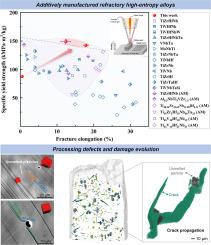定向能沉积法增材制造难熔高熵合金的工艺缺陷及损伤机理
IF 14.3
1区 材料科学
Q1 MATERIALS SCIENCE, MULTIDISCIPLINARY
引用次数: 0
摘要
耐火高熵合金(RHEAs)由于其固有的抗高温塑性流动软化的特性而成为高温应用的有希望的候选者。然而,它们的脆性使其难以制造具有复杂几何形状的工程部件。通过直接能量沉积(DED)技术的增材制造在设计和成型方面提供了灵活性,但由于组成多主要元素的物理性质的显着差异以及与DED相关的快速凝固条件导致的加工缺陷限制了RHEAs的实际应用。本研究阐明了固有缺陷的形成、抑制策略及其对混合粉末制备的DED Ti41V27Hf13Nb13Mo6 RHEA力学响应的影响。熔池特征与加工参数的相关性表明,激光功率和扫描速度是调节缺陷形成的关键。能量输入不足会导致未熔化缺陷,使打印样品在拉伸试验中变脆。详细的微观结构表征表明,未熔化缺陷作为裂纹成核位点(通过微孔聚结),促进了过早破坏。为了解决这个问题,通过温度场模拟实施了重熔(策略Ⅰ)和高能密度处理(策略Ⅱ),并证明了它们的有效性。策略Ⅰ制备的中等缺陷RHEA的损伤机制主要由裂纹控制,而策略Ⅱ制备的低缺陷RHEA的损伤机制主要由空洞成核控制。在后者中,减少的裂纹有效地抑制了变形过程中的应变局部化。优化后的RHEA拉伸伸长率高达17.9%,屈服强度超过1 GPa。这些发现提供了一个框架,通过定制加工参数来设计延展性的DED RHEAs,以避免缺陷引起的脆性。本文章由计算机程序翻译,如有差异,请以英文原文为准。

Processing defects and damage mechanisms in refractory high-entropy alloys additively manufactured via directed energy deposition
Refractory high-entropy alloys (RHEAs) are promising candidates for high-temperature applications due to their intrinsic resistance to plastic flow softening at elevated temperatures. However, their brittleness makes it difficult to manufacture engineering components with complex geometries. Additive manufacturing via direct energy deposition (DED) technique offers flexibility in design and forming, yet processing defects caused by marked differences in the physical properties of the constituent multi-principal elements and the rapid solidification conditions associated with DED limit RHEAs' practical application. This study elucidates the formation of inherent defects, strategies for their suppression, and their influence on the mechanical response of a DED Ti41V27Hf13Nb13Mo6 RHEA prepared by mixed powders. Correlation of the molten pool characteristics to processing parameters reveals that laser power and scanning speed are pivotal in regulating defect formation. Insufficient energy input induces unmelted defects, rendering as-printed specimens brittle during tensile tests. Detailed microstructural characterization shows that the unmelted defects act as crack nucleation sites (through micropore coalescence), promoting premature failure. To address this, remelting (Strategy Ⅰ) and high-energy density processing (Strategy Ⅱ) were implemented via temperature field simulations and proved to be effective. The damage mechanism of the RHEA with moderate defects fabricated via Strategy Ⅰ is primarily governed by cracking, whereas that of the low-defect-content RHEA produced via Strategy Ⅱ is dominated by void nucleation. In the latter, reduced cracking effectively suppresses strain localization during deformation. The optimized RHEA exhibits a high tensile elongation of 17.9% and a yield strength exceeding 1 GPa. These findings offer a framework to design ductile DED RHEAs by tailoring processing parameters to avoid defect-induced brittleness.
求助全文
通过发布文献求助,成功后即可免费获取论文全文。
去求助
来源期刊

Journal of Materials Science & Technology
工程技术-材料科学:综合
CiteScore
20.00
自引率
11.00%
发文量
995
审稿时长
13 days
期刊介绍:
Journal of Materials Science & Technology strives to promote global collaboration in the field of materials science and technology. It primarily publishes original research papers, invited review articles, letters, research notes, and summaries of scientific achievements. The journal covers a wide range of materials science and technology topics, including metallic materials, inorganic nonmetallic materials, and composite materials.
 求助内容:
求助内容: 应助结果提醒方式:
应助结果提醒方式:


